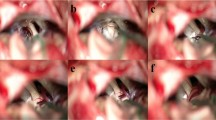Abstract
Background
The suprameatal tubercle (SMT) may obscure the neurovascular compression (NVC) in microvascular decompression (MVD) for trigeminal neuralgia (TGN). The aim of this study is to address the necessity of resecting SMT in MVD for TGN.
Methods
We retrospectively analyzed radiological findings of 461 MVDs in patients with TGN, focusing on the relation between SMT and the NVC site. Three-dimensional (3D) images were used for preoperative evaluation. The NVC sites were obscured by SMT in 48 patients (10.4%) via the retrosigmoid approach. This study was conducted to review the management of SMT among these patients. Resection of SMT was performed in 8 patients (resected group) for direct visualization of the NVC site. On the other hand, nerve decompression was achieved without resecting SMT for the rest of the 40 patients (non-resected group). Biographical data, radiological findings, intraoperative findings, and surgical outcomes were retrospectively evaluated.
Results
The mean height of SMT obscuring NVC was 5.0 mm (2.8–13.9 mm) above the petrous surface. The NVC was located at a mean of 1.9 mm (0–5.9 mm) from the porous trigeminus. The most common offending vessel was the superior cerebellar artery (SCA, 56.3%), followed by the transverse pontine vein (TPV, 29.2%). In the resected group, the transposing culprit vessels were feasibly performed after direct visualization of the NVC site, whereas in the non-resected group, the SCA was successfully transposed using curved instruments after thorough dissection around the nerve. TPV having contact with the nerve was coagulated and divided. Immediate pain relief was obtained in all patients except one who experienced delayed pain relief 1 month after surgery. Facial numbness at discharge was noted in 9 patients (18.8%); thereafter, numbness diminished over time. Numbness at the final visit was observed in 5 patients (10.4%) at mean of 49 months after MVD. Recurrent pain occurred in 4 patients (8.3%) in total. Statistical analysis showed no significant differences in surgical outcomes between both groups.
Conclusions
Direct visualization of the NVC site by resecting the SMT does not affect surgical outcomes in the immediate and long term. Resecting the SMT is not always necessary to accomplish nerve decompression in most cases by use of suitable instruments and techniques.




Similar content being viewed by others
References
Acerbi F, Broggi M, Gaini SM, Tschabitscher M (2010) Microsurgical endoscopic-assisted retrosigmoid intradural suprameatal approach: anatomical considerations. J Neurosurg Sci 54:55–63
Chanda A, Nanda A (2006) Retrosigmoid intradural suprameatal approach: advantages and disadvantages from an anatomical perspective. Neurosurgery 59:1–6
Ebner FH, Koerbel A, Roser F, Hirt B, Tatagiba M (2009) Microsurgical and endoscopic anatomy of the retrosigmoid intradural suprameatal approach to lesions extending from the posterior fossa to the central skull base. Skull Base 19:319–323
Inoue T, Hirai H, Shima A, Suzuki F, Yamaji M, Fukushima T, Matsuda M (2017) Long-term outcomes of microvascular decompression and gamma knife surgery for trigeminal neuralgia: a retrospective comparison study. Acta Neurochir 159:2127–2135
Ishi Y, Asaoka K, Sugiyama T, Yokoyama Y, Yamazaki K, Echizenya S, Itamoto K, Echizenya K (2015) Case report: trigeminal neuralgia caused by a minute meningioma with hyperostosed suprameatal tubercle. Case Rep Neurol 167–172
Jannetta PJ (1967) Arterial compression of the trigeminal nerve at the pons in patients with trigeminal neuralgia. J Neurosurg 26:159–162
Jannetta PJ (1976) Microsurgical approach to the trigeminal nerve for tic douloureux. Prog Neurol Surg 7:180–200
Koerbel A, Kirschniak A, Ebner FH, Tatagiba M, Gharabaghi A (2009) The retrosigmoid intradural suprameatal approach to posterior cavernous sinus: microsurgical anatomy. Eur J Surg Oncol 35:368–372
Lovely TJ, Jannetta PJ (1997) Microvascular decompression for trigeminal neuralgia: surgical technique and long-term results. Neurosurg Clin N Am 8:11–29
Moreira-Holguin JC, Revuelta-Gutierrez R, Monroy-Sosa A, Almeida-Navarro S (2015) Suprameatal extension of retrosigmoid approach for microvascular decompression of trigeminal nerve: case report. Int J Surg Case Rep 15:13–16
Samii M, Tatagiba M, Carvalho GA (2000) Retrosigmoid intradural suprameatal approach to Meckel’s cave and the middle fossa: surgical technique and outcome. J Neurosurg 92:235–241
Seoane E, Rhoton AL Jr (1999) Suprameatal extension of the retro-sigmoid approach: microsurgical anatomy. Neurosurgery 44:553–560
Shenouda EF, Coakham HB (2007) Management of petrous endostosis in posterior fossa procedures for trigeminal neuralgia. Neurosurgery 60:63–69
Sindou M, Howeidy T, Acevedo G (2002) Anatomical observations during microvascular decompression for idiopathic trigeminal neuralgia (with cor- relations between topography of pain and site of the neurovascular conflict). Prospective study in a series of 579 patients. Acta Neurochir 144:1–13
Acknowledgments
We thank Ms. Satomi Fujimura and Ms. Lori Radcliffe for assistance with data collection and English language editing.
Author information
Authors and Affiliations
Corresponding author
Ethics declarations
Conflict of interest
The authors declare that they have no conflict of interest.
Ethical approval
All procedures performed in studies involving human participants were in accordance with the ethical standards of the institutional and/or national research committee and with the 1964 Helsinki declaration and its later amendments or comparable ethical standards.
Informed consent
Informed consent was obtained from all individual participants included in the study.
Additional information
Publisher’s note
Springer Nature remains neutral with regard to jurisdictional claims in published maps and institutional affiliations.
This article is part of the Topical Collection on Functional Neurosurgery - Pain
Rights and permissions
About this article
Cite this article
Inoue, T., Goto, Y., Prasetya, M. et al. Resection of the suprameatal tubercle in microvascular decompression for trigeminal neuralgia. Acta Neurochir 162, 1089–1094 (2020). https://doi.org/10.1007/s00701-020-04242-8
Received:
Accepted:
Published:
Issue Date:
DOI: https://doi.org/10.1007/s00701-020-04242-8




